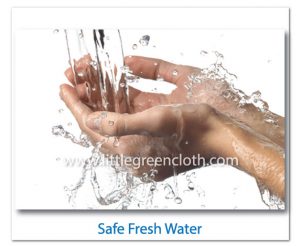 SAFE FRESH WATER – A BASIC HUMAN RIGHT!!
SAFE FRESH WATER – A BASIC HUMAN RIGHT!!
“Access to safe water is a fundamental human need and, therefore, a basic human right. Contaminated water jeopardizes both the physical and social health of all people. It is an affront to human dignity.”
Kofi Annan, United Nations Secretary-General
Over 70% of our earth’s surface is covered by water. Although water seems to be abundant, 97.5% of all water on earth is salt water. Less than 3% is fresh water!
Nearly 70% of that fresh water is frozen in the icecaps of Antarctica and Greenland. Less than 1% of the world’s fresh water is accessible for direct human use! This is the water found in lakes, rivers, reservoirs and those underground sources that are shallow enough to be tapped at an affordable cost. It is this amount only that is renewed by rain and snowfall and is available on a sustainable basis.
Today there are many problems that are associated with the world’s fresh water supply. The supply is steadily decreasing! Water demand already exceeds supply in many parts of the world. As the world population continues to rise, so does the water demand. The current estimate by the United States Census Bureau puts the world population at 6,830,200,000 and will reach seven billion by July 2012. The accompanying increases in usage of resources are linked to threats to the ecosystem, such as rising levels of atmospheric carbon dioxide, global warming, and pollution.
Another issue that impacts the world’s fresh water supply is its fitness to drink. Water pollution has degraded the fitness in many water sources! Some sources of water pollution come from raw sewage disposal in water systems, trash dumping, excessive sediments from soil erosion, chemical waste being dumped into drains and water systems, and petroleum pollution from people pouring used oil down storm drains. In addition, chemicals and other raw wastes are dumped worldwide by industries and even by governments into the oceans. Most coastal waters are now polluted. Beaches around the world are closed regularly, often because of high amounts of bacteria from sewage disposal, and marine wildlife is beginning to suffer. Then too there are catastrophic disasters such as the BP oil rig explosion causing millions of gallons of crude oil to pollute the Gulf of Mexico and the shorelines.
The health and economic impacts of today’s global water crisis and lack of sanitation are staggering. According to the World Health Organization, 1.1 billion people worldwide lack access to clean water —that’s approximately one in six people on earth! Some statistics include :
1) Every 15 seconds, a child dies from water-related diseases.
2) Every day 4,500 children die from water-related diseases.
3) 1.8 million children die each year from diarrhea, generally from drinking contaminated water.
4) Water-related diseases are the leading cause of death for children under age 5.
5) Children in poor environments often carry 1,000 parasitic worms in their bodies at any time.
6) Children – and particularly girls – are denied their right to education because their schools lack private and decent sanitation facilities.
7) Half of all the world’s hospital beds are occupied by patients suffering from a water-related disease. 8) Close to half of all people in developing countries are suffering from health problems caused by water and sanitation deficits.
9) Contaminated water and lack of sanitation claims more lives through disease than any war claims through guns.
10) 2.5 billion people lack access to improved sanitation, including 1.2 billion people who have no facilities at all.
11) It is estimated that improved sanitation facilities could reduce diarrhea-related deaths in young children by more than one-third. If hygiene promotion is added, such as teaching proper hand washing, deaths could be reduced by two thirds.
12) Each person needs 4 to 5 gallons of water per day to survive.
13) Millions of women and children spend several hours a day collecting water from distant, often polluted sources.
14) Two thirds of all families lacking access to clean water live on less $2 a day.
15) Every $1 spent on water and sanitation creates a savings of $8 in other costs and increased productivity.
16) No other service has greater impact upon families and nations than providing safe drinking water and the proper disposal of human waste.
Just because we live in the United States, we are not immune to the water crisis. Scientists estimate 7 million Americans are sickened by contaminated tap water every year, and nearly 40% of our rivers fail to meet current clean water standards! We should not take our water for granted, yet too many of us do. Some alarming statistics regarding U.S. water scarcity and water quality include :
1) Water managers in 36 states expect water shortages by 2013, according to the U.S. Government Accountability Office.
2) One-third of all U.S. water withdrawals are for export.
3) California has a 20-year supply of freshwater left.
4) New Mexico has only a ten-year supply of freshwater left.
5) Florida‚ rapid use of groundwater has created thousands of sinkholes that devour anything , houses, cars and shopping malls , unfortunate enough to be built on top of them.
6) The U.S. interior west is probably the driest it has been in 500 years, according to the National Academy of Sciences and the U.S. Geological Survey.
7) In 2007, Lake Superior, the world‚ largest freshwater lake, dropped to its lowest levels in 80 years and the water has receded more than 15 meters from the shoreline.
8) Lake Mead, the vast reservoir of the Colorado River, has a 50 percent chance of running dry by 2021.
9) 40 percent of U.S. rivers and streams are too dangerous for fishing, swimming or drinking.
10) 46 percent of U.S. lakes are too dangerous for fishing, swimming or drinking because of massive toxic runoff from industrial farms, intensive livestock operations and the more than 1 billion pounds of industrial weed killer used through the country each year.
11) Two-thirds of U.S. estuaries and bays are moderately or severely degraded.
12) One quarter of U.S. beaches are under advisories or closed due to water pollution.
13) 1.5 million metric tons of nitrogen pollution are carried by the Mississippi River into the Gulf of Mexico every year.
One of the biggest reasons for developing a worldwide effort to monitor and restrict global pollution is the fact that most forms of pollution do not respect national boundaries! In September 2000, world leaders came together at United Nations Headquarters in New York to adopt the United Nations Millennium Declaration, committing their nations to a new global partnership to reduce extreme poverty and setting out a series of time-bound targets – with a deadline of 2015 – that have become known as the Millennium Development Goals.
One of the Millennium Development Goals that all 192 United Nations member states and at least 23 international organizations have agreed to achieve by the year 2015 is to ensure environmental sustainability. Its goal is to halve, by 2015, the proportion of people without sustainable access to safe drinking water and basic sanitation! Solving water quality problems requires strategies to prevent, treat, and remediate or reverse water pollution. These strategies will require awareness building, increased monitoring, and better governance and regulation worldwide. International water quality guidelines can also help to assist countries in developing enforceable water quality standards. Countries and organizations around the world will achieve more by working together to obtain these results.
Due to increased public interest in protecting America’s waters from pollution, the U.S. Congress enacted the Federal Water Pollution Control Act, popularly known as the Clean Water Act (CWA), in 1972! It was amended in 1977 and it became commonly known as the Clean Water Act. The Act established a basic structure for regulating discharges of pollutants into the waters of the United States. Over the years, many other laws have changed parts of the Clean Water Act to strengthen water quality standards and establish better enforcement laws.
Although the facts about water pollution are grim, there are things that people around the world can do to improve the situation. It is ultimately up to all of us to be informed, responsible and involved when it comes to the problems we face with our water!
Here are a few ways in which we can help combat water pollution:
- Conserve and protect clean water.
- Support federal and worldwide programs to extend clean water access.
- Conserve soil to prevent erosion.
- Properly dispose of household and industrial chemicals and waste products.
- Keep machinery in good working order – clean up the residue and dispose of the used oils properly.
- Clean-up beaches and waterways.
- Pick up litter wherever it’s found.
- Avoid plastics when possible – plastic bags in oceans is a well documented water pollutant.
- Use natural household cleaning agents and products.
- Make an effort to keep lakes, streams, rivers, and other bodies of water clean.
- Use sand or cat litter to melt ice in the winter instead of salt.
- In our yards, we must determine whether additional nutrients are needed before fertilizers are applied, and look for alternatives where fertilizers might run off into surface waters.
- Preserve existing trees and plant new trees and shrubs to help prevent soil erosion and promote infiltration of water into the soil.
- Around our houses, keep litter, pet waste, leaves, and grass clippings out of gutters and storm drains.
- Consider taking shorter showers.
- Invest in a low-flow toilet or put a plastic bottle filled with water in your toilet tank to reduce the amount of water used per flush.
- Turn off the tap while brushing teeth or shaving.
- Run dishwashers or laundry machines only when full.
- Use water left over from cooking for houseplants.
- Choose landscaping plants with low water requirements. Consider reducing your lawn size and replacing turf grass with native plants, shrubs, and trees that generally grow well without a lot of excess watering.
- Eat foods that require less water to produce. The amount of water used to produce animal products and processed foods like soda and chips far exceeds the amount used for growing vegetables and grains.
- When grocery shopping, try to buy more whole foods like vegetables that are in season, and a variety of grains, legumes, nuts, and seeds.
- Patronize businesses with sound water conservation practices.
- Carry a refillable water container rather than buying bottled water. Production, transportation, and disposal of bottled water consume large quantities of water (and energy).
A compelling reason to green your cleaning is that many of the synthetic and toxic chemicals found in common household cleaning products contain ingredients that are potentially hazardous to us, our children, the environment, and our fresh water!
http://www.globalchange.umich.edu/globalchange2/current/lectures/freshwater_supply/freshwater.html
http://en.wikipedia.org/wiki/World_population
http://www.un.org/millenniumgoals/bkgd.shtml
http://en.wikipedia.org/wiki/Millennium_Development_Goals
http://greenliving.lovetoknow.com/Water_Pollution_Solutions





Leave a Reply